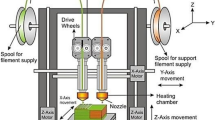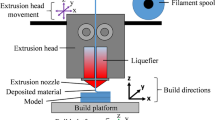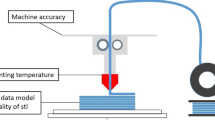Abstract
Fused Filament Fabrication (FFF) is one of the most popular extrusion based metal Additive Manufacturing (AM) Technologies, which has unique advantages in the rapid prototyping of thermoplastic materials, enabling the fabrication of metal parts with low mechanical anisotropy and no residual stress. However, the mechanical properties and dimensional accuracy of FFF printed parts are susceptible to changes in various printing parameters, which affects the FFF application in large-scale manufacturing. This study experimentally studied the effect of various printing parameters namely layer thickness (0.1, 0.2, 0.3, and 0.4 mm), raster angle (0°, 90°, + 45°/−45°, and 0°/90°), raster width (0.3, 0.35, 0.4, and 0.45 mm), and infill density (70, 80, 90, and 100%) on mechanical properties and dimensional accuracy of 316L stainless steel fabricated by FFF. The results showed that the infill density was the most important factor affecting the mechanical properties, followed by the layer thickness, and it was found that higher values of infill density and lower layer thickness result in better tensile strength. Layer thickness was also the main factor affecting the dimensional accuracy, which increased with the decrease in the layer thickness.



Source: Raise3D











Similar content being viewed by others
References
I. Skawiński and T. Goetzendorf-Grabowski, FDM 3D printing Method Utility Assessment in Small RC Aircraft Design, Aircr. Eng. Aerosp. Tec., 2019, 91(6), p 865–872.
D.K. Yadav, R. Srivastava, and S. Dev, Design & Fabrication of ABS Part by FDM for Automobile Application, Mater. Today. Proc., 2020, 26, p 2089–2093.
Z. Peng, Q. Lv, J. Jing, H. Pei, Y. Chen, and E. Ivanov, FDM-3D Printing LLDPE/BN@GNPs Composites with Double Network Structures for High-Efficiency Thermal Conductivity and Electromagnetic Interference Shielding, Compos. Part B Eng., 2023, 251, p 110491.
L. Hoffmann, J. Breitkreutz, and J. Quodbach, Investigation of the Degradation and In-Situ Amorphization of the Enantiomeric Drug Escitalopram Oxalate During Fused Deposition Modeling (FDM) 3D Printing, Eur. J. Pharm. Sci., 2023, 185, p 106423.
E. Chen, Z. Xiong, X. Cai, S. Liu, X. Qin, J. Sun, X. Jin, and K. Sun, Bioresorbable PPDO Sliding-Lock Stents with Optimized FDM Parameters for Congenital Heart disease treatment, J. Mech. Behav. Biomed., 2023, 138, p 105609.
R. Ramesh-Kumar, D. Rajesh, S. Kumaran, S. Ranjieth, M.I. Ali, and K. Karthik, Investigation on Tensile Characteristics of Femur Bone 3D Model by Using FDM, Mater. Today. Proc., 2022, 52, p 1504–1508.
M.A. Wagner, A. Hadian, T. Sebastian, F. Clemens, T. Schweizer, M. Rodriguez-Arbaizar, E. Carreño-Morelli, and R. Spolenak, Fused Filament Fabrication of Stainless Steel Structures - From Binder Development to Sintered Properties, Addit. Manuf., 2022, 49, 102472.
H. Ramazani and A. Kami, Metal FDM A New Extrusion-Based Additive Manufacturing Technology for Manufacturing of Metallic Parts: A Review, Progr. Addit. Manuf., 2022, 7(4), p 609–626.
S. Rouf, A. Raina, M.I. Ul Haq, N. Naveed, S. Jeganmohan, and A.F. Kichloo, 3D Printed Parts and Mechanical Properties: Influencing Parameters, Sustainability Aspects, Global Market Scenario, Challenges and Applications, Adv. Indus. Eng. Polym. Res., 2022, 5(3), p 143–158.
X. Sun, M. Mazur, and C.-T. Cheng, A Review of Void Reduction Strategies in Material Extrusion-Based Additive Manufacturing, Addit. Manuf., 2023, 67, 103463.
F. Gorana, K.K. Sahu, and Y.K. Modi, Parameter Optimization for Dimensional Accuracy of Fused Deposition Modelling Parts, Mater. Today. Proc., 2023, 78, p 640–646.
B. Zharylkassyn, A. Perveen, and D. Talamona, Effect of Process Parameters and Materials on the Dimensional Accuracy of FDM Parts, Mater. Today. Proc., 2021, 44, p 1307–1311.
C. Tosto, J. Tirillò, F. Sarasini, and G. Cicala, Hybrid Metal/Polymer Filaments for Fused Filament Fabrication (FFF) to Print Metal Parts, Appl. Sci., 2021, 11(4), p 1444.
T. Kurose, Y. Abe, M.V.A. Santos, Y. Kanaya, A. Ishigami, S. Tanaka, and H. Ito, Influence of the Layer Directions on the Properties of 316L Stainless Steel Parts Fabricated through Fused Deposition of Metals, Mater., 2020, 13(11), p 2493.
D. Godec, S. Cano, C. Holzer, and J. Gonzalez-Gutierrez, Optimization of the 3D Printing Parameters for Tensile Properties of Specimens Produced by Fused Filament Fabrication of 17–4PH Stainless Steel, Materials, 2020, 13(3), p 774.
M.Á. Caminero, A.R. Gutiérrez, J.M. Chacón, E. García-Plaza, and P.J. Núñez, Effects of Fused Filament Fabrication Parameters on the Manufacturing of 316L Stainless-Steel Components: Geometric and Mechanical Properties, Rapid. Prototyp. J., 2022, 28(10), p 2004–2026.
S. Kheiri, H. Mirzadeh, and M. Naghizadeh, Tailoring the Microstructure and Mechanical Properties of AISI 316L Austenitic Stainless Steel via Cold Rolling and Reversion Annealing, Mater. Sci. Eng. A, 2019, 759, p 90–96.
Raise3D MetalFuse, 2023. https://www.raise3d.cn/metalfuse/ (accessed 9 Sept 2023)
Technical Data Sheet. Ultrafuse 316L 3D Printer Metal Filament, 2022. https://forward-am.com/material-portfolio/ultrafuse-filaments-for-fused-filaments-fabrication-fff/metal-filaments/ultrafuse-316l/ (accessed 9 Sept 2023)
M.A. Wagner, J. Engel, A. Hadian, F. Clemens, M. Rodriguez-Arbaizar, E. Carreño-Morelli, J.M. Wheeler, and R. Spolenak, Filament Extrusion-Based Additive Manufacturing of 316L Stainless Steel: Effects of Sintering Conditions on the Microstructure and Mechanical Properties, Addit. Manuf., 2022, 59, 103147.
Y. Wang, L. Zhang, X. Li, and Z. Yan, On Hot Isostatic Pressing Sintering of Fused Filament Fabricated 316L Stainless Steel–Evaluation of Microstructure, Porosity, and Tensile Properties, Mater. Lett., 2021, 296, p 129854.
J. Damon, S. Dietrich, S. Gorantla, U. Popp, B. Okolo, and V. Schulze, Process Porosity and Mechanical Performance of Fused Filament Fabricated 316L Stainless Steel, Rapid. Prototyp. J., 2019, 25(7), p 1319–1327.
L. Ren, X. Zhou, Z. Song, C. Zhao, Q. Liu, J. Xue, and X. Li, Process Parameter Optimization of Extrusion-Based 3D Metal Printing Utilizing PW–LDPE–SA Binder System, Materials, 2017, 10(3), p 305.
I. Buj-Corral, A. Bagheri, A. Domínguez-Fernández, and R. Casado-López, Influence of Infill and Nozzle Diameter on Porosity of FDM Printed Parts with Rectilinear Grid Pattern, Proc. Manuf., 2019, 41, p 288–295.
K.M. Agarwal, P. Shubham, D. Bhatia, P. Sharma, H. Vaid, and R. Vajpeyi, Analyzing the Impact of Print Parameters on Dimensional Variation of ABS specimens printed using Fused Deposition Modelling (FDM), Sens. Int., 2022, 3, 100149.
M.M. Hanon, L. Zsidai, and Q. Ma, Accuracy Investigation of 3D printed PLA with Various Process Parameters and Different Colors, Mater. Today. Proc., 2021, 42, p 3089–3096.
Y. Liu, M. Zhang, W. Shi, Y. Ma, and J. Yang, Study on performance optimization of 316L stainless steel parts by High-Efficiency Selective Laser Melting, Opt. Laser Technol., 2021, 138, 106872.
N. Lecis, M. Mariani, R. Beltrami, L. Emanuelli, R. Casati, M. Vedani, and A. Molinari, Effects of Process Parameters, Debinding and Sintering on the Microstructure of 316L Stainless Steel Produced by Binder Jetting, Mater. Sci. Eng. A, 2021, 828, 142108.
Acknowledgments
Thanks are due to Jingguang Peng and Qingqing Pan for valuable discussions, to Wei Mai for providing experimental guidance, and to Qile Shi and Ziqi Liu for assistance with the experiments.
Author information
Authors and Affiliations
Corresponding authors
Ethics declarations
The authors declare that they have no conflict of interest.
Additional information
Publisher's Note
Springer Nature remains neutral with regard to jurisdictional claims in published maps and institutional affiliations.
Rights and permissions
Springer Nature or its licensor (e.g. a society or other partner) holds exclusive rights to this article under a publishing agreement with the author(s) or other rightsholder(s); author self-archiving of the accepted manuscript version of this article is solely governed by the terms of such publishing agreement and applicable law.
About this article
Cite this article
Wang, C., Mai, W., Shi, Q. et al. Effect of Printing Parameters on Mechanical Properties and Dimensional Accuracy of 316L Stainless Steel Fabricated by Fused Filament Fabrication. J. of Materi Eng and Perform (2023). https://doi.org/10.1007/s11665-023-08848-8
Received:
Revised:
Accepted:
Published:
DOI: https://doi.org/10.1007/s11665-023-08848-8




